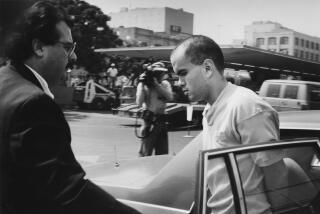Man Convicted of Widowâs Slaying Gets New Trial, Fashionable Defense
FORT PIERCE, Fla. â Victor Brancaccio looked at the white-haired lady who had criticized his foulmouthed rapping--her nose broken, her blood on his fist--and made a critical decision.
âI should help her, you know, and say Iâm sorry,â the former altar boy later told police, âor continue what Iâm doing.â
He continued. Continued by dragging the 81-year-old widow into a field. Continued punching and kicking. Continued jumping on her rib cage. Continued bashing her skull with a toy gun. Continued, until Mollie Mae Frazier could no longer put up a fight, could no longer get him in trouble, prosecutors said.
Her body was found June 12, 1993, in the upscale neighborhood of Port St. Lucie on the Florida east coast, where Brancaccio grew up and Frazier lived in retirement. Brancaccioâs friends led police to the body, saying that the 17-year-old had bragged about killing a woman who had scolded him for rapping the vulgar lyrics of the Dr. Dre tune âStranded on Death Rowâ as he walked down the street.
Criminal Actions, Chemical Substances
Now, five years later, a legal technicality is giving Brancaccio a chance to save himself from life imprisonment.
An appeals court overturned his 1995 conviction on murder and kidnapping charges and ordered a new trial.
And this time he will be backed by renowned defense attorney Roy Black--who successfully defended William Kennedy Smith against rape charges. In a bizarre twist of fortune, his parents, who claimed that they had lost their home and business trying to finance his first defense, are financing his new defense with $2.8 million they won in the Florida lottery.
The teenagerâs attorneys have maintained that Brancaccio was insane at the time of the slaying, suffering from mental illness, learning disorders and a mix of beer and antidepressants.
A new trial was ordered in August 1997 when the 4th District Court of Appeal ruled that the trial judge erred in not giving the jury a specific instruction to consider whether Brancaccio was âinvoluntarily intoxicatedâ by either alcohol or antidepressants or both.
This is the latest in a pattern of cases in recent years in which defendants have blamed their actions on substances from diet pills to sugar to sexual-performance enhancers.
In January, a Weston, Fla., woman charged with embezzling an elderly womanâs money blamed the fen-phen diet pill combination. She is awaiting trial. And in July 1997, a Minnesota man accused of killing his wife and a Coast Guard petty officer accused of rape both claimed that their actions were the result of taking the antidepressant Prozac. They were convicted.
Brancaccio is suing the psychiatric hospital that treated him, claiming that he would not have assaulted the woman had the hospital not discharged him when his medical insurance expired.
Blackâs associate, Scott Kornspan, said the attorneys would not discuss Brancaccioâs case before a jury is selected.
Assistant State Atty. Lawrence Mirman, prosecutor in both trials, said he did not know how strategies would differ the second time around.
Certainly the issue of Brancaccioâs mental well-being, and whether he was rendered somehow insane by alcohol or the prescription antidepressant Zoloft, will figure prominently in the retrial.
Brancaccioâs short life has long been troubled.
Defense attorney Vincent Flynn told the first jury that he was born prematurely to parents who are first cousins. At 18 months he nearly drowned, relatives testified.
He developed into a small and slow-witted child--some experts say he bordered on retarded--struggling with schoolwork, authority and depression. He believed that his parents favored his brother over him, records show.
âAs soon as he started kindergarten, we knowed that he was slow,â his father, Gene Brancaccio, said in court papers.
Victor Brancaccio, now 22, reacted physically to anger--once breaking the nose of a classmate who insulted him. He had to do community service as punishment, Mirman said.
âA Time Bomb, a Walking Time Bombâ
In early 1993, Brancaccio was arrested on suspicion of stealing beer from a convenience store and committed for three weeks to a psychiatric hospital after threatening to kill himself and his parents.
He was put on Zoloft and released one month before Frazierâs death. His doctor at the time told his parents, âVictor right now is a time bomb, a walking time bomb,â his father said in a sworn statement.
On the night of the murder, Brancaccio fought with his mother over pizza, refusing to order from Roma Pizza, the familyâs store, Mirman said.
Brancaccio grabbed his headset, Dr. Dre tape and a toy Beretta handgun and set out to get some air in his neighborhood--a community of model homes built to cater to retirees who frequent nearby golf courses.
Within a block, he ran into Frazier, according to a transcript of his confession.
She asked him to stop cursing and he slugged her, he said. He told police he realized he needed to hurt her enough so she would not be able to get him in trouble.
âHe beat her body, jumped on her rib cage and crushed her ribs,â prosecutor Mirman said. âAfter he beat her, he went back to life as usual.â
The next day, though, he returned to the body. He tried to burn it with crumpled newspapers and petroleum jelly, but it did not work, authorities said. He grabbed cans of red paint from his garage--the same paint heâd used to paint his go-cart--and doused her body to try to cover his fingerprints, police records show.
In the end, his bragging was his undoing. He had shown his friends the blood on his sneakers and later took them to the field to show off the body, the friends told police. His fingerprints were found on the paint cans, and one of the widowâs hairs was embedded in his toy gun, Mirman said.
âShe was strong for an old lady,â Brancaccio told one of his friends, according to Mirman.
By law, prosecutors cannot seek the death penalty again because Brancaccio was sentenced to life in prison the first time.
Mirman aims to lay out a case based largely on the facts supplied by Brancaccio himself, and hopes for a conviction on first-degree felony murder and kidnapping.
âWhat the state does in a case like this is it takes the facts and explains them in a common-sense way. [He] . . . belts her, slugs her, then decides she should not testify against him,â Mirman said. âThere you have it.â
More to Read
Sign up for Essential California
The most important California stories and recommendations in your inbox every morning.
You may occasionally receive promotional content from the Los Angeles Times.










